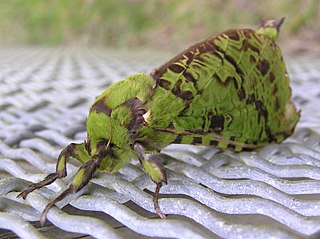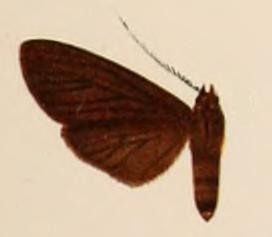
Amorphophallus is a large genus of some 200 tropical and subtropical tuberous herbaceous plants from the Arum family (Araceae), native to Asia, Africa, Australia and various oceanic islands. A few species are edible as "famine foods" after careful preparation to remove irritating chemicals. The genus includes the Titan arum of Indonesia, which has the largest inflorescence of any plant in the genus, and is also known as the 'corpse flower' for the pungent odour it produces during its flowering period, which can take up to seven years of growth before it occurs.

Aenetus is a genus of moths of the family Hepialidae. There are 24 described species found in Indonesia, New Guinea, New Caledonia, Australia and New Zealand. Most species have green or blue forewings and reddish hindwings, but some are predominantly brown or white. The larvae feed in the trunks of living trees, burrowing horizontally into the trunk, then vertically down.

Endoclita is a genus of moths of the family Hepialidae. There are 60 described species found in eastern and southeast Asia and the Indian subcontinent.

Theretra silhetensis, the brown-banded hunter hawkmoth, is a moth of the family Sphingidae described by Francis Walker in 1856. It lives in Indo-Australia, India, Sri Lanka, Papua New Guinea, East Australia, Solomon Islands, Fiji Islands, Vanuatu Islands.

Digama is a genus of moths in the family Erebidae described by Frederic Moore in 1858. It is distributed in South Africa, China, throughout India, Sri Lanka, Myanmar and Australia.

Machairophora is a genus of moths in the subfamily Arctiinae first described by George Hampson in 1893. Two species are included, which are found from Sri Lanka and Papua New Guinea only.

Pelochyta is a genus of moths in the family Erebidae. The species was first described by Jacob Hübner in 1819. They are distributed in Africa, throughout India, Myanmar, Sri Lanka, Australia and New Britain.

Culladia is a grass moth genus of subfamily Crambinae, tribe Crambini. Some authors have assigned the synonymous taxon Nirmaladia to the snout moth family (Pyralidae), where all grass moths were once also included, but this seems to be in error.
Arguda is a genus of moths in the family Lasiocampidae first described by Frederic Moore in 1879. Species are distributed in Himalayan regions and Nilgiri Mountains of India, Sri Lanka, Myanmar, the Philippines, Singapore and Australia.

Metanastria is a genus of moths in the family Lasiocampidae described by Jacob Hübner in 1820. The species of this genus are found in Europe, Japan, China, South Africa, throughout India, Sri Lanka, Myanmar, Java and Borneo.
Chlorodontopera is a monotypic moth genus in the family Geometridae described by Warren in 1893. Its only species, Chlorodontopera chalybeata, described by Frederic Moore in 1872, is found in the north-eastern Himalayas, northern Vietnam, Myanmar, Borneo and Sumatra.

Leucania loreyi, the cosmopolitan, false army worm or nightfeeding rice armyworm, is a moth of the family Noctuidae. It is found in most of African countries, the Indo-Australian subtropics and tropics of India, Sri Lanka, Myanmar, the eastern Palearctic realm, and the Near East and Middle East. The species was first described by Philogène Auguste Joseph Duponchel in 1827.

Pergesa is a monotypic moth genus in the family Sphingidae first described by Francis Walker in 1856. Its only species, Pergesa acteus, the green pergesa hawkmoth, was described by Pieter Cramer in 1779.

Berta chrysolineata is a species of moth of the family Geometridae described by Francis Walker in 1863. It is widespread from the Indo-Australian tropics of India, Sri Lanka to the Solomons.
Endoclita purpurescens is a species of moth of the family Hepialidae. It was described by Frederic Moore in 1883 and is known from Sri Lanka. Food plants for this species include Camellia and Cinchona.
Palpifer murinus is a moth of the family Hepialidae. It is found in India. The food plant for this species is Colocasia.
Palpifer sexnotatus is a moth of the family Hepialidae. It is found in India and Japan. Food plants for the species include Amorphophallus and Colocasia.
Palpifer sordida is a moth of the family Hepialidae. It was described by Pieter Cornelius Tobias Snellen in 1900. It is found in Java, Indonesia. Food plants for this species include Alocasia, Amorphophallus, and Dioscorea.
Palpifer taprobanus is a moth of the family Hepialidae. It was described by Frederic Moore in 1887 and is found in Sri Lanka.

Thalassodes quadraria is a species of moth of the family Geometridae first described by Achille Guenée in 1857. It is found in Africa south of the Sahara and in India and Sri Lanka.












